Albumin Wrinkle Smoothers
In 1964, Helene Curtis Industries, Inc. introduced Magic Secret into the American market in a blaze of magazine and television commercials reminiscent of the Charles Antell Touch-Up Stik advertisements that ran ten years earlier.

Above: 1964 Helene Curtis Magic Secret.
See also: Corrective Make-up (Concealers)
Magic Secret was advertised as a wrinkle smoothing lotion that “smoothes away wrinkles in minutes, [and] keeps them away for hours”. Selling at US$5 an ounce it quickly caused Helene Curtis shares to jump from US$18 to US$42 a share.
Magic Secret was followed by a number of similar products including Coty’s Line Away, Hazel Bishop’s Sudden Change, Studio Girl’s Soft-Focus Temporary Wrinkle Remover, Max Factor’s Touch of Youth Wrinkle Smoothing Lotion, Lilly Daché’s Instant Change, and Revlon’s Wonderlift Wrinkle Remover. All of these wrinkle smoothers were based on the same ingredient, bovine serum albumin, a protein extracted from the blood of cattle.
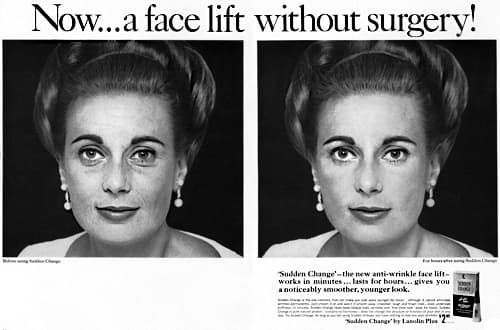
Above: 1964 Hazel Bishop Sudden Change (Lanolin Plus division).
Almost as soon as Magic Secret was released rumours began circulating that the American Food and Drug Administration (FDA) was investigating the product, and the stock price of Helene Curtis, that had been so buoyant, tumbled. The FDA seized shipments of Magic Secret in April of 1964 claiming that the labelling and advertising was false and misleading – which meant the product was ‘misbranded’ – and followed this with seizures of comparable products. It took nearly seven years of litigation before the original Helene Curtis seizure decision was reversed, and these products could be sold on the American market as cosmetics (deNavarre, 1975). However, by then, the cost to Helene Curtis had reached US$6 million and the company had stopped dividend payments to shareholders (Allen, 1981, p. 150).
Egg albumins
Albumin in egg white had been used as a wrinkle remover for centuries before the arrival of Magic Secret. When egg white is applied to the skin it produces a tightening feeling and appears to smooth wrinkles. The tightening effect is produced 5-10 minutes after the egg white is applied as the albumin dries out on the skin. The face muscles had to be kept still during the treatment, otherwise the mask would crack and any feeling of tightness would be lost.
As eggs were usually readily available, ‘egg masks’ or ‘egg packs’ were commonly included in beauty books as a wrinkle treatment all through the twentieth century.
Most skins will benefit from an egg pack, probably one of the cheapest forms of beautifying treatment known. Separate the white from the yolk of the egg, and put the yolk away for a few moments. Beat up the white until it becomes fluffy, and add a few drops of lemon juice, then apply to the face which has already been cleaned with warm water. Let it remain on the face about twenty minutes, then remove with warm water, followed by cold, and the application of a piece of ice.
(“How to attain and retain beauty,” 1935, p. 163)
Most of these egg treatments included astringents, cold water and/or ice to help sustain the feeling of tightness.
Also see: Skin Tonics, Astringents and Toners
Early commercial albumin treatments
Although the effect of egg white was common knowledge, there were only a few attempts to produce a commercial albumin-based product before the 1960s. Most of these were based on albumin sourced from blood plasma rather than from eggs. The earliest that I know of was Sérofar.
Laboratoires Sérofar
Sérofar was a French commercial wrinkle serum made from horse blood plasma. Introduced in the early 1930s, it was developed from work done by Prof. Jacques C. Risler in the 1920s, it had only limited success and seems to have disappeared by 1939.
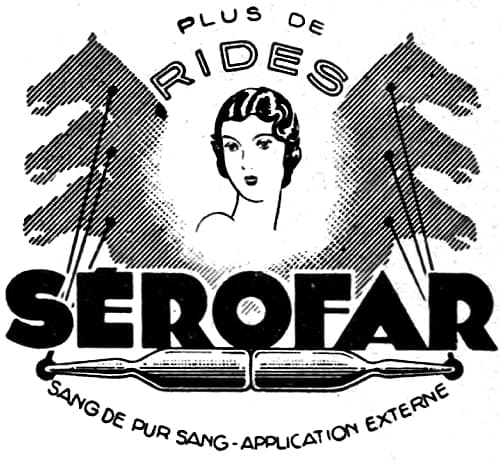
Above: 1936 Logo of Laboratoires Sérofar, 16 Avenue Hoche, Paris. Note the inclusion of an ampule and the horse heads.
As a 1939 study on the use of horse serum in skin treatments indicated, many French cosmetic chemists thought that blood serum was absorbed into the skin where it had a rejuvenating effect on skin cells (Leduc, 1939). This idea was based on earlier French investigations into rejuvenation therapies using tissue extracts, based on the work of Alexis Carrel [1873-1944] and others.
See also: Embryo Extracts
These ideas meant that Sérofar’s claims for its product went beyond the ‘mask’ effect created by albumin as it tightens on the skin.
There is a good deal of talk in Trade circles about the rejuvenation of the skin by means of a serum made from the blood of the horse. This method of beauty culture, which is being demonstrated in the laboratories where the serum is prepared, 36, Avenue Hoche, has been announced as a great biological discovery, and the results I myself have noted certainly justify the claim. The serum has been named “Serofar.” It is curious to note that this discovery, the work of a well known savant of the Faculty of Medicine, of Paris, is to a certain extent based on the old idea that the application of beef-steak on the face at night just before going to sleep was very efficacious as regards facial beauty. Wrinkles are due to a weakening of the tissues, the result of a slackening of the blood current; therefore, the makers of “Serofar” claim, a preparation such as this—veritably the “blood of a thoroughbred”—will have the effect of regenerating the human cells. The tissues will be resuscitated, the wrinkles will disappear, hollow cheeks will fill out, and the skin once more become firm and smooth. I may add that this new preparation is agreeably scented, and that its application needs no expert knowledge.
(The Hairdresser and Beauty Trade, 1933, p. 22)
Primrose House and Helena Rubinstein
Other attempts to commercialise serum albumin were made in the 1950s. In 1952, Primrose House introduced Le Secret de Blanche Delysia, imported from Paris.
Now! One of the most revolutionary beauty treatments of all time is being imported direct from Paris for women over 40 (or younger if their skin is aging.) It’s the only beauty treatment of its kind. Nothing can even begin to compare with it.
(Primrose House advertisement, 1952)
The following year, Helena Rubinstein launched Skin Serum also imported from France. It contained amniotic fluid along with blood serum.
Look for almost immediate results—your skin seems tighter, more moist due to an invisible film which helps to effectively hide every tiny line and blemish. Droop and dryness are counteracted—so simply, so neatly.
(Helena Rubinstein advertisement, 1952)
Both products were only advertised through the print media and appear to have received little consumer interest in the American market. Helene Curtis Magic Secret, and the other products that followed it, generated a good deal more consumer demand because they were advertised through television.
Blood serum albumin
Although albumin can be extracted from a range of sources, such as eggs, ovaries, or placentas, like Sérofar in the 1930s, the products released into the American market in the 1960s, such as Magic Secret, used blood serum albumin, primarily because it was easy to extract.
In the manufacture of bovine albumin, sodium citrate is added to fresh blood to prevent its coagulation, and the blood is centrifuged to remove the blood cells. The anticoagulant is then neutralized and the serum is defibrinated and spray dried. The resulting product is light in colour and completely water soluble; its albumin content is about 80-95%. Bovine albumin is available from several sources in three forms: as a 15% sterile solution containing a suitable preservative and ready for immediate use without dilution; as a 30% solution to be diluted with an equal volume of water prior to use, and also in the form of a freeze-dried powder which before use is reconstituted with water.
(Harry, 1973, p. 109)
Proteins such as albumin are very vulnerable to bacterial and fungal attack when in an aqueous solution. Dr. Jacques C. Risler had to place his product in sterile ampules – one ampule for each treatment – with the protein preserved with oxyquinoline (deNavarre, 1975, p. 1369). Adding advanced preservatives (parabens) significantly improved the shelf life of this type of product. Using small bottles also helped forestall degradation as the serum would be quickly used up after the bottle was first opened, giving it less time to be contaminated.
Two simple formulations are given by deNavarre for an albumin cosmetic – one for egg albumin and one for albumin extracted from ovaries.
Formula 1
Parts by Weight Egg albumin 3.0 Alcohol (70%) 1.5 Formula 2
Parts by Weight Alcohol 35 Boric acid 1 Albumin [extracted from ovaries] 1 Water and perfume, q.s. 100 (deNavarre, 1975, pp. 1369-1370)
The recipes above would not produce a commercially viable wrinkle smoother. As well as water, bovine serum albumin and preservative, wrinkle smoothers of the 1960s contained film-forming agents, such as carboxymethylcellulose and sodium silicate, to help deliver a uniform film when applied, and make the film more matt so it was less visible. In addition, they contained plasticisers, such as glycerine or propylene glycol, to increase the flexibility of the film so that it would resist cracking, scaling and flaking, a major problem with earlier attempts of this type of cosmetic. Together these ingredients reduced many of the problems of previous wrinkle smoothers and they also made it possible to apply a wrinkle smoother under makeup, or to incorporate pigments into ts formulation, further increasing its visual effectiveness.
Effectiveness of albumin
Even though Magic Secret claimed to smooth wrinkles there was no published data to support this claim at the time. Nor did anyone have any scientific understanding of how albumin produced the wrinkle-smoothing effect, although cosmetic chemists had known about it for at least half a century. Two scientists, Dr. Albert M. Kligman [1916-2010] and Dr. Christopher M. Papa, decided to investigate the process and tested Magic Secret on 50 subjects, publishing their results in 1965.
As the solution dries within a few minutes, the subjects noted a “tightening” sensation, and coincidently, effacement of wrinkles was observed. The smoothing effect reaches a maximum within three to eight minutes. Under the stereoscopic skin microscope (Seitz) the finest wrinkles gradually become invisible, and moderate creases become shallower. All individuals respond, though to varying degrees. The largest furrows on the forehead and marked expression lines around the eyes and mouth are not markedly altered unless very large amounts are applied. When small amounts are used, the residue is essentially nonvisible even with magnification. Larger amounts than are required to reduce minor wrinkles may leave a rather fine transparent film which may later scale or flake. Repeated applications during the day may lead to a fine peeling which is the dried residue itself. The duration of the peak effect is two to six hours, depending on facial mobility. It is longest in the “poker-faced,” inexpressive, passive person, whose face registers little emotion. … When the effect begins to wane, re-moistening of the skin with a few drops of water will more or less reinstate what was lost. Even after eight hours, the wetting maneuver will palpably reduce the finer wrinkles, though usually not as completely as a fresh application. On the other hand, thorough washing of the face with soap and water at any time after drying will completely and instantly abolish the smoothening effect.
The antiwrinkling effect did not appear to be cumulative with repeated daily use. The cosmetic improvement was as great on the first as on the last day of use. Facial creams, applied after the solution dries, do not materially alter the effect. No adverse reactions have been encountered, and evidently, repeated use has not resulted in sensitization or irritation.(Kligman & Papa, 1965, p. 558)
Albumin and skin smoothing
Although albumin causes a feeling of tightness on the skin there was no real evidence that the tightness was associated with the skin smoothing effect – the two processes may have been coincidental not causative. It is possible that the wrinkle smoothing effect of the albumin was due to it filling in the cracks, like putty, or to the refractive index of the albumin visually softening the wrinkle lines. In fact, if you think about it, it would appear more likely that a substance which contacted the skin would produce a puckering/wrinkling effect rather than a smoothing one. When Kligman and Papa applied a strongly contracting material to the face, like Duco cement, this was exactly the result they got – aggravated wrinkles!
Stereomicroscopic examination of the skin after Magic Secret was applied indicated that the smoothing effect was not due to infilling of the wrinkles but rather was caused by the albumin contracting. Kligman and Papa suggested how this might work.
Senile facial skin is loose and flabby and can be easily extended or stretched by a minor force which would have lesser effects on young skin. This laxness reflects the degeneration of the underlying connective tissue. The normal feltwork of elastic and collagen fibers is markedly altered. The elastic tissue is greatly increased, while collagen fibers, the main dermal component, are physically degraded and reduced. As the solution dries, the contractile tension will tend to pull on the surrounding skin which, however, yields little. Instead, the force generated on the lax skin lifts up the furrows to the normal surface, thereby obliterating them. The action is simply one of elevating the wrinkles to the level of the surrounding skin.
(Kligman & Papa, 1965, p. 558)
There was some disagreement with this explanation. Saad and Karg of Avon Product Research and Development ruled out the refractive index of the protein film as the cause of the wrinkle softening effects but suggested that the albumin protein uncoiled when it dried, thereby stretching the skin rather than contracting it.
It is now believed that the effectiveness of the serum albumin wrinkle smoothers is due to the unfolding of the protein helical structure on drying which forces the skin outwards and thus smoothing the wrinkles.
(Saad & Karg, communication from deNavarre, 1975, p. 1374)
This suggestion had important ramifications for cosmetic chemistry because, if true, it would rule out using synthetic polymers instead of albumin, as they were contractile in nature. However, current evidence suggests that Saad and Karg were incorrect and that many water-soluble polymers (many of which were patented) have similar effects to albumin without the sensitisation and degradation issues associated with using animal proteins.
Current uses of albumin
Like those of the 1930s, the albumin wrinkle smoothers of the 1960s proved to be less successful than hoped. As well as issues with allergies, stability and some discomfort, the products had no lasting effects and were ineffective against deep wrinkles, particularly in areas that women find important, such as the neck. It is likely that many women tried the product and then reverted to their usual creams.
However, apart from a brief period in the 1990s when Mad Cow Disease (BSE) attracted considerable attention and some products were recalled, serum albumins continued to be added to many wrinkle-reducing cosmetics. Rather than being used alone, they are now generally combined with other wrinkle-reducing ingredients including hydrating agents to plump up the skin, fillers to fill in the cracks, and optical masks to disperse light and add a softening effect. Many of these products concentrate on the eyes – where the skin is thinner and more likely to respond – and promise to smooth away bags, puffiness and wrinkles.
First Posted: 2nd March 2016
Last Update: 10th February 2021
Sources
Agencies choose tv for intro of new wrinkle-smoothers. (1964). Sponsor. 18(1), 34-36.
Allen, M. (1981). Selling creams: Inside the beauty business. London: J. M. Dent & Sons Ltd.
deNavarre, M. G. (1975). Wrinkle smoothers. In Maison G. deNavarre (Ed.). The chemistry and manufacture of cosmetics (2nd. ed., Vol. IV, pp. 1369-1378). Orlando: Continental Press.
The hairdresser and beauty trade. (1933). December 16, 42. London.
Harry, R. G. (1973). Harry’s cosmeticology. (6th ed.). London: Leonard Hill Books.
How to attain and retain beauty. (1935). London: Hazell, Watson & Viney.
Kligman, A. M., & Papa, C. M. (1965). Albumin as an antiwrinkling cosmetic. Journal of the Society of Cosmetic Chemists. 16, 557-562.
Leduc, L. (1939). Le sérum de cheval. La Parfumerie Moderne. April, No. 4, 133-139.
Leeds, L., & Kaji, H. M. (1927). Beauty and health a practical handbook. Philadelphia: J. B. Lippincott Company.
La Science au Service de l’Esthétique: Le “SÉROFAR”. (1932). L’Afrique du Nord Illustree. 29(707), 13.
Stabile, T. (1969). Cosmetics: Trick or treat? (3rd ed.). New York: Arco Publishing Company, Inc.
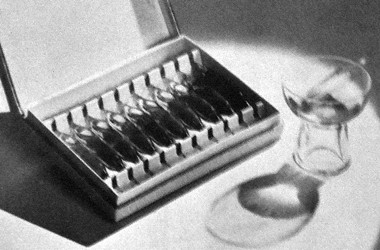
1932 Although not specifically labelled as such, these glass ampules packed in a gold and cream case were probably produced by Laboratoires Sérofar.
The action of the albumin in the horse plasma produced a tightening effect on the skin but the product was also touted as containing the ‘essential element of life’ which was easily absorbed into the skin. When used in a salon it was recommended that the skin be first heated with warm compresses, infra-red rays or diathermy to increase absorption of the serum. This would relax the facial tissues thereby increasing the tightening feeling the serum produced. After the serum was removed, cold water or ice was applied to close the pores, constrict blood vessel and extend the feeling of tightness.
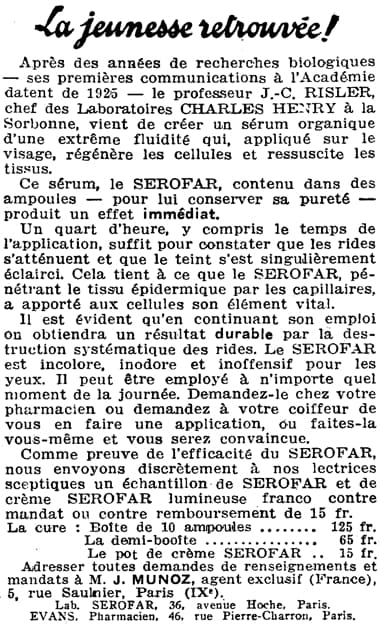
1934 Serofar.
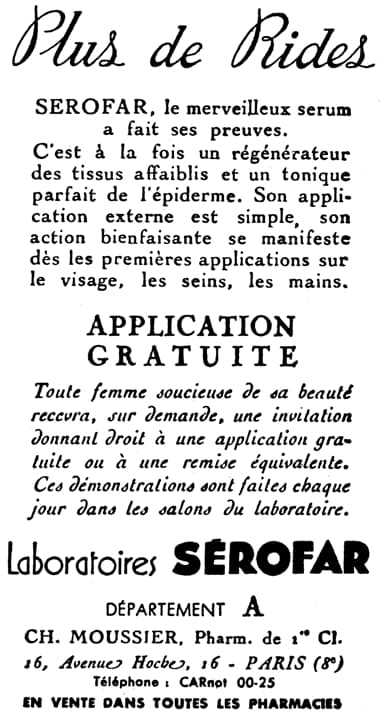
1935 Serofar.
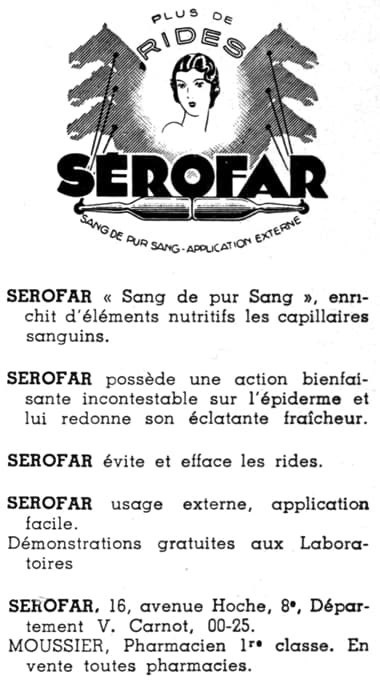
1936 Serofar.

1952 Le Secret de Blanche Delysia by Primrose House. The product came in vials, one of which was to be applied every day for five days, then every other day for a week, then two each week.
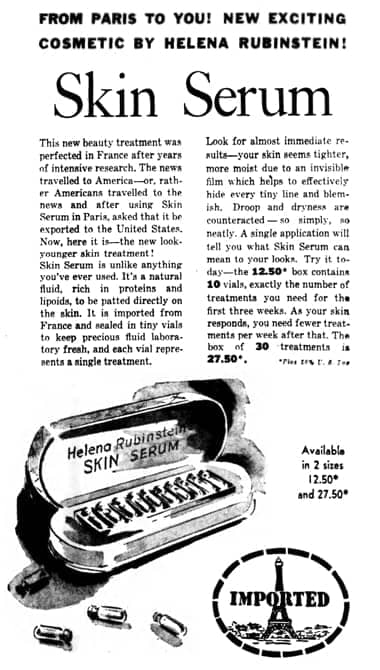
1953 Helena Rubinstein Skin Serum.

1964 Helene Curtis Magic Secret made from serum albumin supplied by Amour & Co. The photograph used the old trick of having the ‘before’ face smiling, to add wrinkles, while the ‘after’ face is relatively passive to reduce visible facial lines.
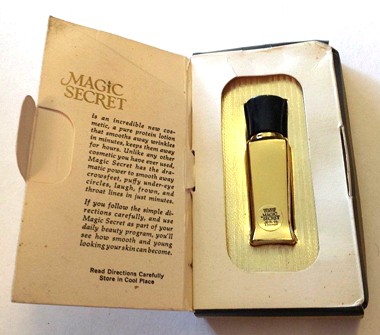
Helene Curtis Magic Secret. The FDA action was the main reason the company made a loss of over US$485,000 in 1965, due to unsold inventory and advertising that could not be cancelled.
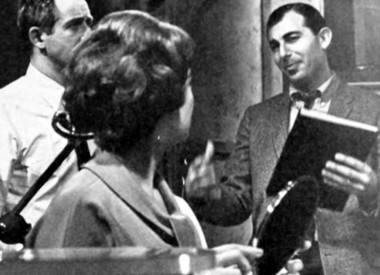
1964 Coty Line Away television advertisement. Agency and production personel ready the model for the shoot (Sponsor, 1964).
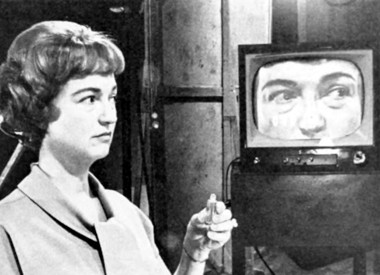
1964 Coty Line Away television advertisement. The model gets ready to put on drops of Coty’s Line Away on the left eye only with the clock set at 0:00. The model’s head is clamped so that it does not move (Sponsor, 1964).

1964 Coty Line Away television advertisement. When the time is up the three minutes of tape are reduced so that it fits into a one-munite commercial. The effect is condensed through animation (Sponsor, 1964).
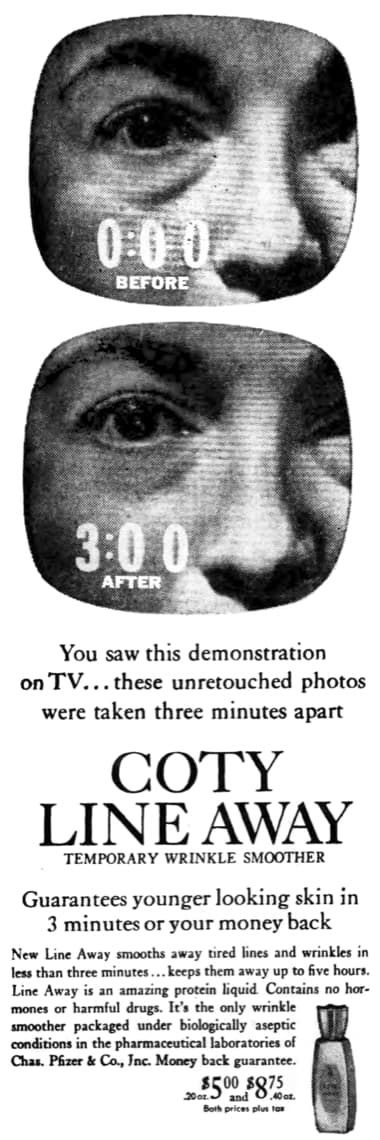
1964 Coty Line Away temporary wrinkle smoother. Their albumin serum came from Charles Pfizer & Co.
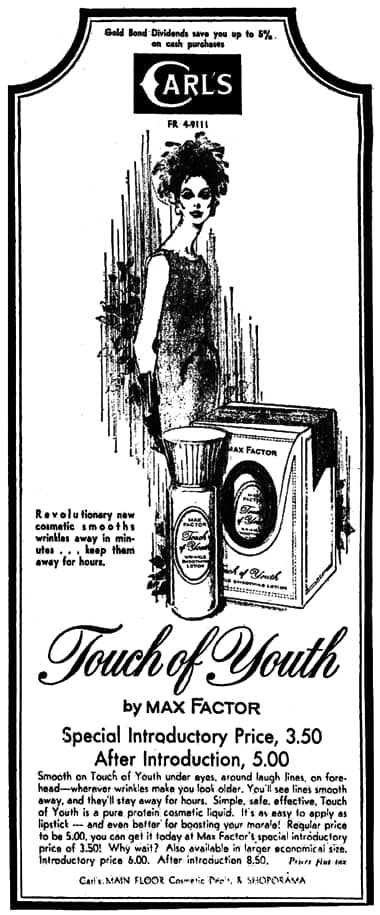
1964 Max Factor Touch of Youth.
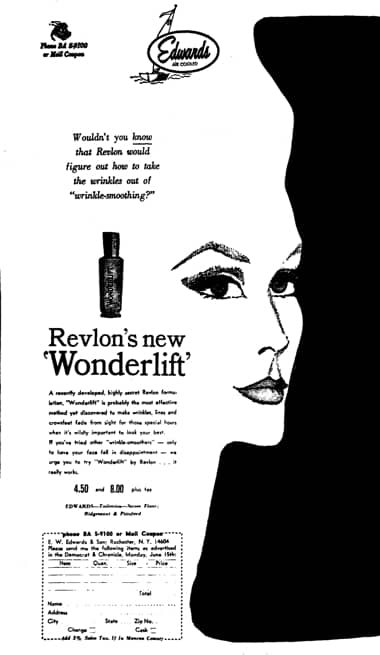
1964 Revlon Wonderlift.

Diagram showing the effect of bovine serum albumin on wrinkles (deNavarre, 1975)
